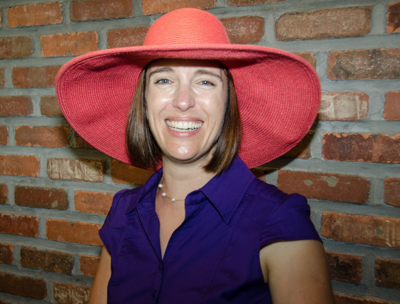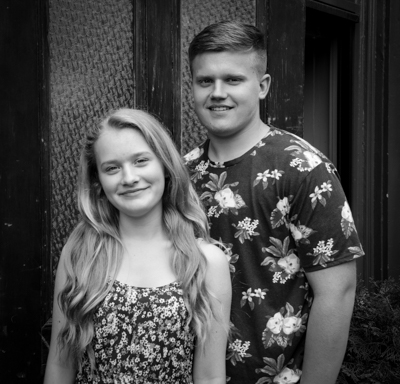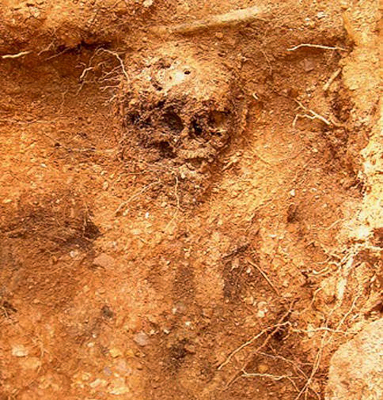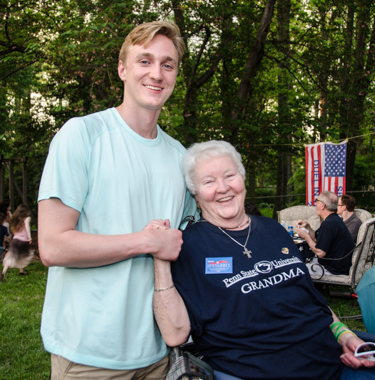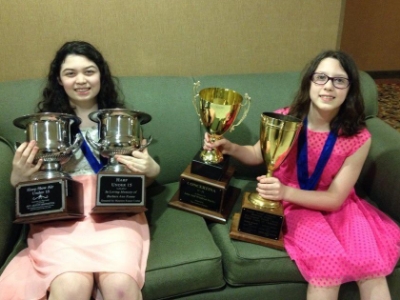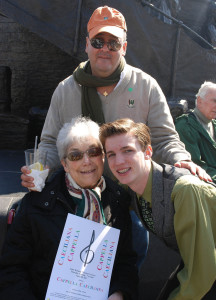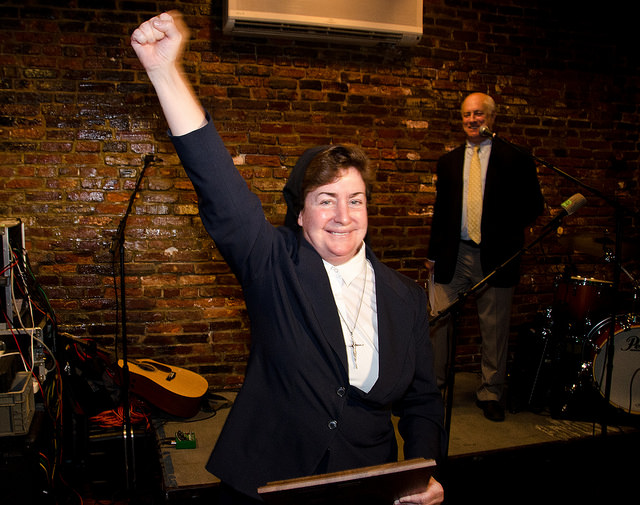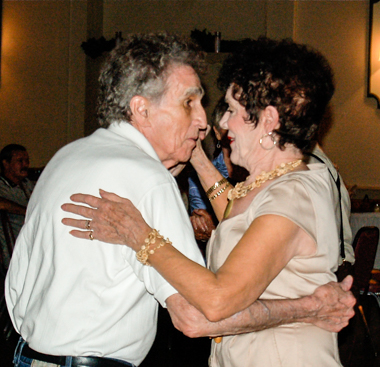
Ed and Mary Reavy as most usually saw them.
A group of Irish musicians, led by 87-year-old Tyrone native Kevin McGillian and his sons John and Jimmy, were playing dance music at the front of St. Kevin’s Church in Springfield on Tuesday morning, as hundreds filed in to pay their last respects to Ed Reavy Jr.
Dance music at a funeral? Ed Reavy would have loved it. In fact, he would have been up there in front of the church, kicking up his heels with his wife, Mary. And it wouldn’t have been the first time the Reavys danced in the aisle of church, as Father John McNamee noted in his homily during the Mass of Christian Burial for the 89-year-old Reavy, who was known as a teacher of ceili dance teachers in the Philadelphia area.
The former pastor of St. Malachy’s Church in North Philadelphia, which was built by Irish immigrants, recalled one November Sunday at the annual fundraising concert in the church organized by famed Irish musician and folklorist Mick Moloney. Something—the sound or the lights—wasn’t working.
“So I got up in the pulpit and announced that the show wasn’t going to start on time, but it might make the time pass if Ed and Mary Reavy got up and danced for us,” recalled the priest. “Mary poked Ed in his side and they got up and danced in the aisle till the concert began. That took a lot of courage.”
Ed Reavy Jr. died last week after a long illness. He was confined to wheelchair, living at the Broomall Presbyterian Village; he hadn’t danced for years. But in the minds and memories of those who came to say goodbye to him, he was still dancing and would forever be. To each person who came to touch her hand or wrap their arms around her, Mary Reavy said tearfully, “I lost my dance partner.”
Many recalled the tap shoes he wore. “He wore those clip shoes up the aisle at his son’s wedding,” said longtime friend Jim McNicholas whose wife and Ed’s first wife were cousins. “All you could hear as he walked was clip, clip, clip.”
And they remembered his stories. His father, the late Cavan-born fiddler Ed Reavy, considered one of the greatest composers of Irish traditional music in the 20th century, was known for his prodigious memory for tunes. One melody would remind him of another and it seemed he could go all night, fiddling the songs of his homeland and the ones he wrote that reminded him of home. His son told stories the same way, in a chain, as one reminded him of another and another.
When her daughter, Caitlin Finley, was a young fiddler, said Denys Everingham, “Ed took an interest in her as he did all the young musicians he liked to encourage. He would talk to her about all her musical mentors at the time. He told her stories about how he used to sit on the stairway of their house and listen to them playing downstairs with his father. She gave him a CD of friend who was an All-Ireland fiddler—he really knew a good fiddler when he heard one—and he commented on how good his slow airs were. Then he told her about a pretty famous fiddler he knew. ‘He couldn’t do a slow air to save his life,’ he told her. That really made us laugh. He had several copies of his father’s tunes left and he gave one to Caitlin. He did so much to promote the music and the culture. He really touched a lot of people.”
He’s credited with helping revive ceili dancing, a form of Irish country dancing, in the Delaware Valley in the 1970s, when Irish music regained a foothold in the region’s Irish community. The dances were staple stuff at Reavy house parties and at the many dance halls in Philadelphia where the Irish would gather, like 69th Street and Connelly’s on Broad Street. Many of the people who teach it today learned from Reavy. And dance was brought Ed, then a widower, together with Mary McGoff, who took lessons from him and became his wife.
“I really remember his dancing,” said Lorraine McDade Kelly, whose late sister, Maureen, founded the McDade School of Irish Dance in Delaware County. “He would kick his heels up really high.” She smiled at the memory. “I got to know him because my dad, Jimmy McDade, was a musician who played with his father. And I would see him at the nursing home. On or around St. Patrick’s Day, Irish musicians would show up to play for him and the other residents. Once he gave me a photo of my Dad that he found, and he was such a story teller, he could tell me the whole story of where it was and what was going on when it was taken.”
The Reavys, particularly Ed’s brother Joe, dedicated their lives to keep their father’s music and name alive. Reavy compositions were being passed from musician to musician and in some cases, attributed to other composers or “anonymous.” In the 1960s, Joe Reavy began transcribing and annotating their father’s tunes from the elder Reavy’s homemade 78s and that remarkable memory. Joe produced the first Ed Reavy songbook in 1980.
The last of Ed Jr.’s 17 visits to Ireland came in 2010 when, with Mary, he was the guest of honor at a tribute concert to his father at the Fleadh Choeil in County Cavan where the first annual Ed Reavy Sr. Traditional Music Festival will be held October 15-18 this year in Cootehill and Cavan Town. (See below for some photos from that event, graciously provided to us by the Ed Reavy Festival committee.The other photos are from our archives.)
On May 15, Mick Moloney, who first recorded Ed Reavy Sr. in the 1970s, will be speaking at a special program at the Cavan County Museum on “Ed Reavy: His Music, His Legacy” to kick off the festival.
Bill McKenty—always “Brother Bill” to Reavy—met the man who became his close friend of more than 20 years when McKenty, a ground water scientist by training, was playing in a session at The Bards pub in Philadelphia in the early 1990s. “A gentleman sits next to me and says, ‘that’s good soundin’ flute playing,’’ recalls McKenty. “I said thanks and went up to get a glass of water and someone says, ‘You know who that is, don’t you? That’s Ed Reavy.’ So when I went back I played one of his father’s tunes.”
They started chatting and, as often happened to Ed Reavy, the shared love of music created a friendship. “We started trading music, becoming friends. I did a website for him,” said McKenty. “He’s of that generation where a computer is not appropriate in a home, so he put it in the closet and had a little chair there. We got him a dial-up internet account, and soon he was surfing, burning CDs, having a lot of fun.”
In recent years, Reavy also struck up a friendship with a 15-year-old dancer and fiddler from Tennessee, says McKenty. “His father’s music connected him to this young lady. Somehow she got his number at the nursing home and over the last two to two-and-a-half years they developed a special friendship over the phone. She was so sweet to him, but they never met. But he hooked her up with all kinds of people to help her with her playing, the Brian Conways, Eileen Ivers and Tony DeMarcos of the world. She was devastated when she learned he had died.”
The other memory McKenty cherishes of his friend was the relationship Reavy had with Mary. Reavy’s daughter, Erin Reavy Fredericks, in her eulogy, read by her step-sister’s husband, James Dale, acknowledged the strong bond between her father and her stepmother.
“I know he hung on as long as he did because of your special love,” she wrote in the tribute to her father, who she recalled as a loving father “who showed up to Girl Scout meeting before that was acceptable, tied my shoes, taught me to ride a bike, throw a ball and recognize a good deal at a garage sale.”
“Talk about a marriage,” said McKenty. “That was one where you reach for the stars and they got it. Did you see his poem?”
In the booklet handed out at the funeral Mass was a poem Reavy wrote for Mary called “Rock,” that begins, “I will never forget the first time I saw you, just as I cannot forget when I knew I did not want to go through life without you.”
It ends, presciently, “I have greed of your time and your space within by being in dread of the spectre of life without you so, I entreat that I be taken before your time need I beg the fairness of this could I manage sanity without my Rock.”
“That’s the way he was,” says McKenty. “Vociferously in love with her. It was puppy love, all that and more. I wish I had that. I’ll miss him greatly.”
Along with his wife, Mary, Ed Reavy Jr. is survived by his son, Edward P. Reavy (the late Linda) and his daughter, Erin Fredericks (Michael); his brothers Joseph and George (Pat) and sister, Eileen Carr. He is also survived by his grandchildren Thomas and Cara Fredericks and Colleen Reavy Karpinski (Mark) and Kevin Reavy; his great-grandchildren Emma and Alexander Karpinski; his step-grandchildren Lauren Ashley, Gavin, Brian, Austin and Dalton Coigne and Matthew, Maureen, Patrick and Maeve Dale and his step-great-grandchildren Catherine, Cailin, Patrick and Caroline Ashley.
In lieu of flowers, the family asks that contributions be made in his memory to the Wounded Warrior Project, PO Box 758517, Topeka, KS. 66675
[flickr_set id=”72157652280577022″]

